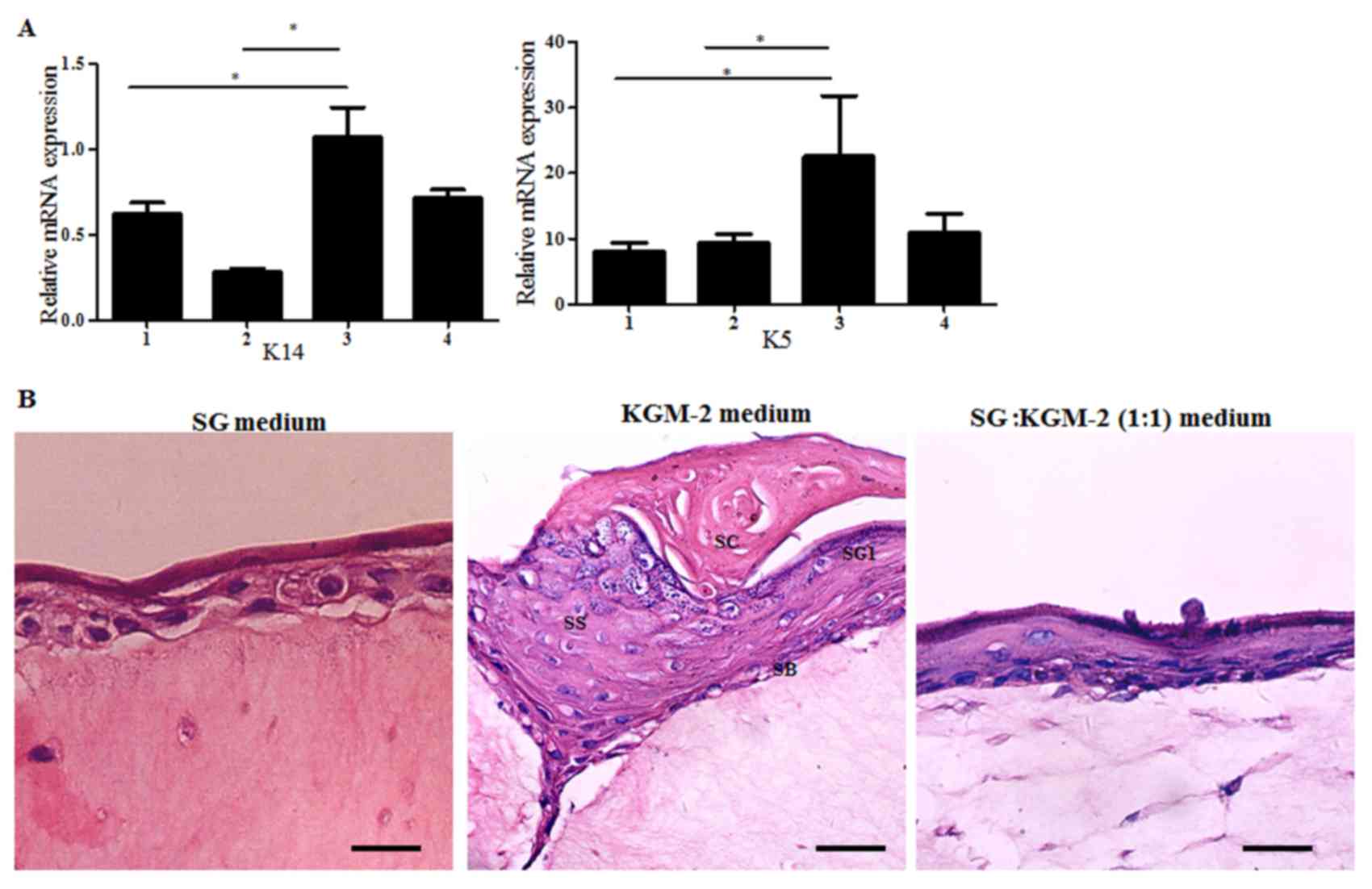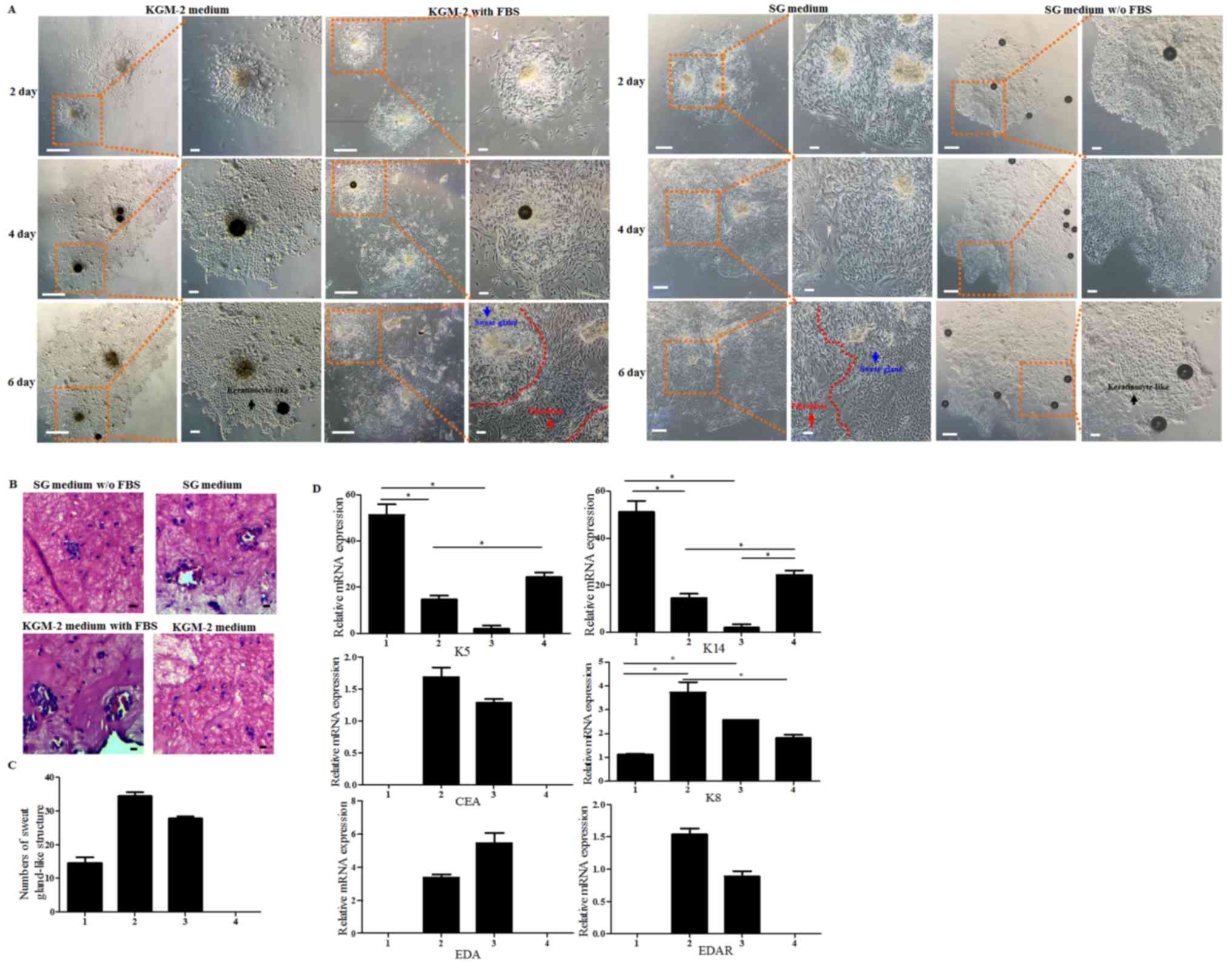|
1
|
Cui CY and Schlessinger D: Eccrine sweat
gland development and sweat secretion. Exp Dermatol. 24:644–650.
2015. View Article : Google Scholar : PubMed/NCBI
|
|
2
|
Dobson RL and Sato K: The secretion of
salt and water by the eccrine weat gland. Arch Dermatol.
105:366–370. 1972. View Article : Google Scholar : PubMed/NCBI
|
|
3
|
Gallico GG III, O'Connor NE, Compton CC,
Kehinde O and Green H: Permanent coverage of large burn wounds with
autologous cultured human epithelium. N Engl J Med. 311:448–451.
1984. View Article : Google Scholar : PubMed/NCBI
|
|
4
|
Danner S, Kremer M, Petschnik AE, Nagel S,
Zhang Z, Hopfner U, ReckhenrichG AK, Weber C, Schenck TL, Becker T,
et al: The use of human sweat gland-derived stem cells for
enhancing vascularization during dermal regeneration. J Invest
Dermatol. 132:1707–1716. 2012. View Article : Google Scholar : PubMed/NCBI
|
|
5
|
Pontiggia L, Biedermann T,
Böttcher-Haberzeth S, Oliveira C, Braziulis E, Klar AS,
Meuli-Simmen C, Meuli M and Reichmann E: De novo epidermal
regeneration using human eccrine sweat gland cells: Higher
competence of secretory over absorptive cells. J Invest Dermatol.
134:1735–1742. 2014. View Article : Google Scholar : PubMed/NCBI
|
|
6
|
Li HH, Zhou G, Fu XB and Zhang L: Antigen
expression of human eccrine sweat glands. J Cutan Pathol.
36:318–324. 2009. View Article : Google Scholar : PubMed/NCBI
|
|
7
|
Li HH, Fu XB, Zhang L and Zhou G:
Comparison of proliferating cells between human adult and fetal
eccrine sweat glands. Arch Dermatol Res. 300:173–176. 2008.
View Article : Google Scholar : PubMed/NCBI
|
|
8
|
Hagmann S, Moradi B, Frank S, Dreher T,
Kämmerer PW, Richter W and Gotterbarm T: Different culture media
affect growth characteristics, surface marker distribution and
chondrogenic differentiation of human bone marrow-derived
mesenchymal stromal cells. BMC Musculoskelet Disord. 14:2232013.
View Article : Google Scholar : PubMed/NCBI
|
|
9
|
Wang Y, Liu ZY, Zhao Q, Sun TZ, Ma K and
Fu XB: Future application of hair follicle stem cells: Capable in
differentiation into sweat gland cells. Chin Med J (Engl).
126:3545–3552. 2013.PubMed/NCBI
|
|
10
|
Böttcher-Haberzeth S, Biedermann T,
Pontiggia L, Braziulis E, Schiestl C, Hendriks B, Eichhoff OM,
Widmer DS, Meuli-Simmen C, Meuli M and Reichmann E: Human eccrine
sweat gland cells turn into melanin-uptaking keratinocytes in
dermo-epidermal skin substitutes. J Invest Dermatol. 133:316–324.
2013. View Article : Google Scholar : PubMed/NCBI
|
|
11
|
Schön M, Benwood J, O'Connell-Willstaedt T
and Rheinwald JG: Human sweat gland myoepithelial cells express a
unique set of cytokeratins and reveal the potential for alternative
epithelial and mesenchymal differentiation states in culture. J
Cell Sci. 112:1925–1936. 1999.PubMed/NCBI
|
|
12
|
Czifra G, Szöllősi AG, Tóth BI, Demaude J,
Bouez C, Breton L and Bíró T: Endocannabinoids regulate growth and
survival of human eccrine sweat gland-derived epithelial cells. J
Invest Dermatol. 132:1967–1976. 2012. View Article : Google Scholar : PubMed/NCBI
|
|
13
|
Lee CM, Carpenter F, Coaker T and Kealey
T: The primary culture of epithelia from the secretory coil and
collecting duct of normal human and cystic fibrotic eccrine sweat
glands. J Cell Sci. 83:103–118. 1986.PubMed/NCBI
|
|
14
|
Biedermann T, Pontiggia L,
Böttcher-Haberzeth S, Tharakan S, Braziulis E, Schiestl C, Meuli M
and Reichmann E: Human eccrine sweat gland cells can reconstitute a
stratified epidermis. J Invest Dermatol. 130:1996–2009. 2010.
View Article : Google Scholar : PubMed/NCBI
|
|
15
|
Lei X, Liu B, Wu J, Lu Y and Yang Y:
Matrigel-induced tubular morphogenesis of human eccrine sweat gland
epithelial cells. Anat Rec (Hoboken). 294:1525–1531. 2011.
View Article : Google Scholar : PubMed/NCBI
|
|
16
|
Tao R, Han Y, Chai J, Li D and Sun T:
Isolation, culture, and verification of human sweat gland
epithelial cells. Cytotechnology. 62:489–495. 2010. View Article : Google Scholar : PubMed/NCBI
|
|
17
|
Lei X, Wu J, Lu Y and Zhu T: Effects of
acetylcholine chloride on intracellular calcium concentration of
cultured sweat gland epithelial cells. Arch Dermatol Res.
300:335–341. 2008. View Article : Google Scholar : PubMed/NCBI
|
|
18
|
Uchida N, Oura H, Nakanishi H, Urano Y and
Arase S: Dispersed cell culture of human sweat duct cells under
serum-free conditions. J Dermatol. 20:684–690. 1993. View Article : Google Scholar : PubMed/NCBI
|
|
19
|
Collie G, Buchwald M, Harper P and Riordan
JR: Culture of sweat gland epithelial cells from normal individuals
and patients with cystic fibrosis. In vitro Cell Dev Boil.
21:597–602. 1985. View Article : Google Scholar
|
|
20
|
Guenou H, Nissan X, Larcher F, Feteira J,
Lemaitre G, Saidani M, Del Rio M, Barrault CC, Bernard FX,
Peschanski M, et al: Human embryonic stem-cell derivatives for full
reconstruction of the pluristratified epidermis: a preclinical
study. Lancet. 374:1745–1753. 2009. View Article : Google Scholar : PubMed/NCBI
|
|
21
|
Sun Q, Li F, Li H, Chen RH, Gu YZ, Chen Y,
Liang HS, You XR, Ding SS, Gao L, et al: Amniotic fluid stem cells
provide considerable advantages in epidermal regeneration: B7H4
creates a moderate inflammation microenvironment to promote wound
repair. Sci Rep. 5:115602015. View Article : Google Scholar : PubMed/NCBI
|
|
22
|
Lu C and Fuchs E: Sweat gland progenitors
in development, homeostasis, and wound repair. Cold Spring Harb
Perspect Med. 4:pii: a015222. 2014. View Article : Google Scholar
|
|
23
|
Morimoto Y and Saga K: Proliferating cells
in human eccrine and apocrine sweat glands. J Histochem Cytochem.
43:1217–1221. 1995. View Article : Google Scholar : PubMed/NCBI
|
|
24
|
Hainfellner JA, Voigtländer T, Ströbel T,
Mazal PR, Maddalena AS, Aguzzi A and Budka H: Fibroblasts can
express glial fibrillary acidic protein (GFAP) in vivo. J
Neuropathol Exp Neurol. 60:449–461. 2001. View Article : Google Scholar : PubMed/NCBI
|














